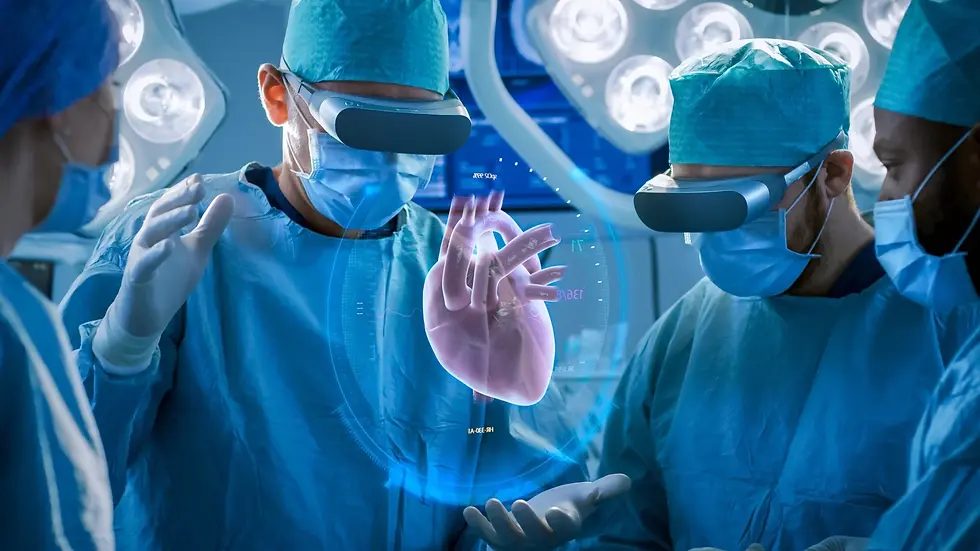AR and VR in Medicine: How Virtual Reality is Changing Surgery and Rehab
- MedWords Editorial

- Aug 9
- 3 min read

A few years ago, the idea of doctors wearing headsets to perform surgeries or patients playing virtual games to recover from injuries might have sounded like pure science fiction. Today, it’s happening in hospitals and clinics worldwide. Augmented Reality (AR) and Virtual Reality (VR) are no longer just for gamers; they’re transforming medicine in ways that are both fascinating and life-changing.
AR vs. VR - What’s the Difference?
Before diving in, let’s clear up the basics:
• Virtual Reality (VR) puts you inside a completely digital environment. In medicine, this could mean a surgeon practicing in a virtual operating room.
• Augmented Reality (AR) overlays digital information on the real world. Think of a surgeon wearing smart glasses that project 3D anatomy onto a patient during surgery.
Both are immersive technologies, but VR is fully virtual, while AR blends the virtual with the real.
Training the Doctors of Tomorrow
Surgical training is traditionally long, expensive, and high-stakes. VR changes that allow medical students and professionals to practice in realistic 3D simulations without risk to actual patients.
For example, companies like Osso VR create detailed surgical simulations where doctors can rehearse procedures as many times as they want, refining their skills before stepping into the real operating room. This kind of training isn’t just safer; it’s also more accessible, as doctors around the world can use it without traveling to specialized centers.
Making Surgery Safer and Smarter
AR is taking surgery to the next level by giving doctors “X-ray vision” in real time. Using AR headsets like Microsoft HoloLens, surgeons can see patient scans, anatomy models, or even live vitals without looking away from the surgical field.
Imagine operating on a tumor and having its exact size and location projected directly over the patient’s body. This reduces guesswork, shortens procedure times, and improves accuracy. It also minimizes invasive cuts, leading to quicker recovery for patients.
A New Era in Physical Rehab
Rehabilitation can be repetitive and mentally exhausting for patients recovering from strokes, spinal injuries, or surgeries. VR is changing that by turning rehab into an interactive, even enjoyable experience.
Patients might find themselves in a virtual park, practicing arm movements by “throwing” a digital ball, or walking along a scenic mountain path while on a treadmill. These immersive environments can boost motivation, track progress in real time, and even help rewire the brain through neuroplasticity, crucial in stroke recovery.
Helping Patients Overcome Pain and Anxiety
Both AR and VR are being used to help patients manage pain and stress. VR can transport someone undergoing a painful procedure into a calm beach scene, reducing their perceived pain. Studies show VR can lower pain scores and anxiety levels for patients in burn units, dental clinics, and even during childbirth.
AR is also helping anxious patients understand medical procedures better by showing them 3D visualizations of their condition and the planned treatment, making the process less intimidating.
Challenges and Limitations
Like any emerging technology, AR and VR in healthcare face some hurdles:
• Cost – High-quality AR/VR systems and content development can be expensive for hospitals.
• Technical Limitations – Hardware needs to be precise and comfortable enough for long use.
• Training Needs – Staff must learn how to use these tools effectively.
• Accessibility – While growing fast, not all healthcare settings can adopt them yet.
Still, as technology becomes more affordable and user-friendly, these barriers are slowly shrinking.
The Road Ahead
The next phase of AR and VR in medicine could involve AI integration, creating hyper-personalized simulations and real-time surgical guidance based on patient-specific data. Imagine a VR system that adapts to your learning speed as a trainee surgeon, or AR that updates surgical visuals as a patient’s vitals change mid-operation.
For patients, future rehab programs might combine VR with wearable sensors to provide more tailored recovery plans. And remote surgeries, where an expert surgeon in one country guides another in real time using AR, are already being tested.
Final Thoughts
AR and VR aren’t replacing doctors; they’re enhancing them. From training surgeons to making rehab engaging, these technologies are bringing precision, safety, and even a bit of wonder into medicine. What once looked like a futuristic dream is quickly becoming standard practice, and that’s good news for both doctors and patients.



Comments